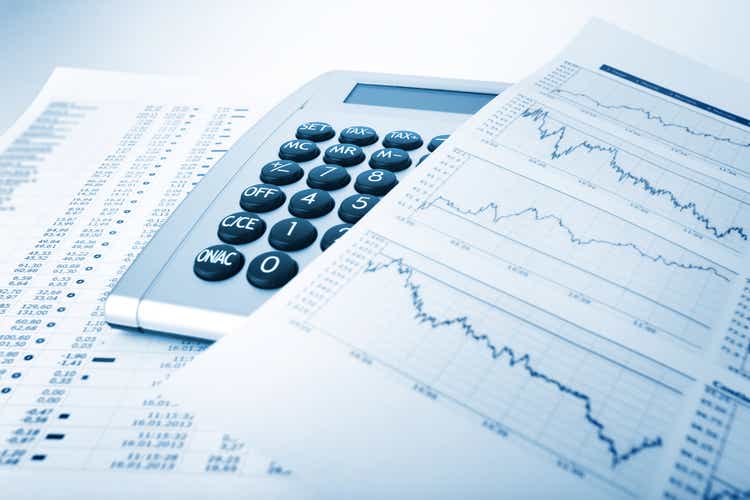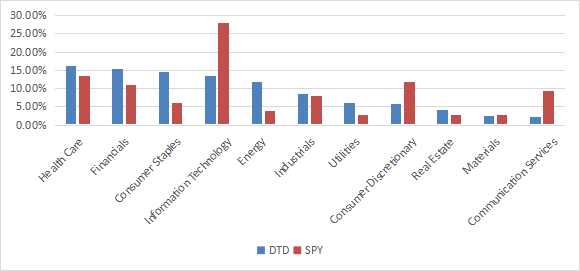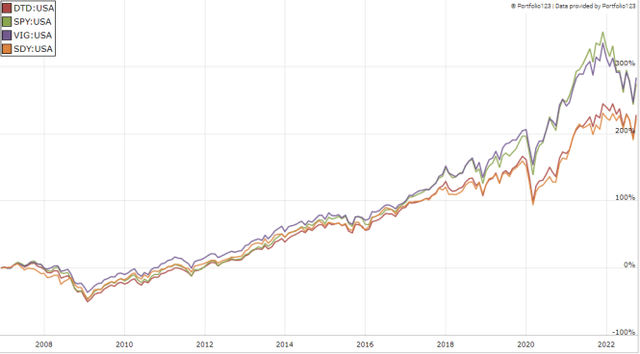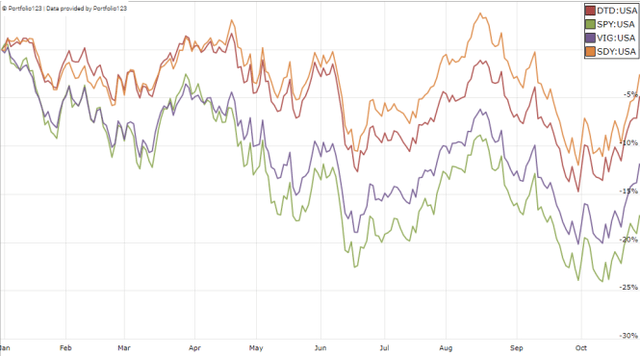deepblue4you
This dividend ETF (exchange-traded fund) article series aims at evaluating products regarding the relative past performance of their strategies and quality metrics of their current portfolios. As holdings and their weights change over time, updated reviews are posted when necessary.
DTD strategy and portfolio
The WisdomTree Total Dividend ETF (NYSEARCA:DTD) has been tracking the WisdomTree U.S. Dividend Index since 06/16/2006. It has a portfolio of 637 stocks, a distribution yield of 2%, and a total expense ratio of 0.28%. It pays monthly distributions.
As described in the prospectus:
The Index measures the performance of U.S. companies, listed on a U.S. stock exchange, that pay regular cash dividends and meet other liquidity and capitalization requirements established by WisdomTree. The index is dividend weighted at the annual reconstitution in December to reflect the proportionate share of the aggregate cash dividends each component company is projected to pay in the coming year.
DTD invests exclusively in U.S.-based companies, mostly in large and mega-cap companies (76% of asset value).
DTD is cheaper than the S&P 500 (SPY) regarding usual valuation ratios, as reported in the table below.
|
DTD |
SPY |
|
|
Price/Earnings |
14.12 |
17.98 |
|
Price/Book |
2.62 |
3.38 |
|
Price/Sales |
1.75 |
2.18 |
|
Price/Cash Flow |
10.79 |
13.63 |
The heaviest sector is healthcare (16.2%), followed by financials (15.3%) and consumer staples (14.4%). Compared to SPY, the fund overweights these top 3 sectors, along with energy, utilities, and real estate. It underweights technology, communication services, and consumer discretionary. As a result, the portfolio is more balanced across sectors than the S&P 500.
DTD sectors (Chart: author; data: WisdomTree, Fidelity)
The top 10 holdings, listed below with weights and some fundamental ratios, represent 26.6% of asset value. The largest holding weighs 4.35%, so risks related to individual stocks are moderate.
|
Ticker |
Name |
Weight |
EPS Growth %TTM |
P/E TTM |
P/E Fwd |
Yield% |
|
Exxon Mobil Corp. |
4.35% |
985.83 |
9.03 |
8.28 |
3.18 |
|
|
Apple Inc. |
3.36% |
8.83 |
25.52 |
24.63 |
0.59 |
|
|
Microsoft Corp. |
3.30% |
3.73 |
25.42 |
24.51 |
1.15 |
|
|
Johnson & Johnson |
2.95% |
7.38 |
24.34 |
17.41 |
2.58 |
|
|
Chevron Corp. |
2.63% |
240.76 |
10.25 |
9.69 |
3.16 |
|
|
JPMorgan Chase & Co. |
2.27% |
-25.07 |
10.64 |
10.98 |
3.17 |
|
|
Pfizer Inc. |
1.96% |
118.65 |
9.29 |
7.41 |
3.37 |
|
|
AbbVie Inc. |
1.95% |
78.95 |
19.65 |
10.65 |
4.01 |
|
|
The Coca-Cola Co. |
1.94% |
12.24 |
26.64 |
24.48 |
2.90 |
|
|
Philip Morris International Inc. |
1.92% |
-2.36 |
16.48 |
16.40 |
5.49 |
Historical performance
Since January 2007, DTD has underperformed SPY and the Vanguard dividend growth ETF (VIG) in total return and risk-adjusted performance (Sharpe ratio). It is very close to the SPDR S&P Dividend ETF.
|
Total Return |
Annual.Return |
Drawdown |
Sharpe Ratio |
Volatility |
|
|
DTD |
226.16% |
7.75% |
-60.48% |
0.47 |
15.45% |
|
SPY |
272.20% |
8.66% |
-55.42% |
0.52 |
16.09% |
|
VIG |
281.13% |
8.82% |
-46.61% |
0.58 |
14.12% |
|
SDY |
219.87% |
7.62% |
-55.52% |
0.46 |
15.85% |
DTD vs. SPY, SDY, VIG since 2007 (Portfolio123)
However, DTD and SDY have beaten the benchmark in 2022:
DTD vs. SPY, SDY, VIG in 2022 (Portfolio123)
In previous articles, I have shown how three factors may help cut the risk in a dividend portfolio: Return on Assets, Piotroski F-score, and Altman Z-score.
The next table compares DTD since inception with a subset of the S&P 500: stocks with above-average dividend yield and ROA, good Altman Z-score and Piotroski F-score, and a sustainable payout ratio. It is rebalanced annually to make it comparable to a passive index.
|
Total Return |
Annual.Return |
Drawdown |
Sharpe Ratio |
Volatility |
|
|
DTD |
226.16% |
7.75% |
-60.48% |
0.47 |
15.45% |
|
Dividend quality subset |
518.24% |
12.20% |
-42.14% |
0.72 |
15.37% |
Past performance is not a guarantee of future returns. Data Source: Portfolio123
The dividend quality subset beats DTD by over 4 percentage points in annualized total return and shows a lower risk in drawdown. However, the fund’s performance is real, whereas the subset is simulated. My core portfolio holds 14 stocks selected in this subset (more info at the end of this post).
Scanning DTD with quality metrics
DTD holds more than 600 stocks, but the top 300 represent almost 90% of the portfolio. I have scanned them with my quality metrics, considering that risky stocks are companies with at least 2 red flags: bad Piotroski score, negative ROA, unsustainable payout ratio, bad or dubious Altman Z-score, excluding financials and real estate where these metrics are less relevant. With these assumptions, 21 of the top 300 holdings are risky. They weigh only 4.2% of asset value, which is a good point.
Based on my calculation, DTD’s weighted Altman Z-score and Piotroski F-score are a bit below the S&P 500. ROA is a bit better. These metrics point to a portfolio quality similar to the benchmark.
|
Atman Z-score |
Piotroski F-score |
ROA % TTM |
|
|
SPY |
3.44 |
5.8 |
7.67 |
|
DTD |
3.21 |
5.7 |
9.47 |
Takeaway
DTD is a broad market dividend ETF with a large portfolio of 637 stocks. As of writing, the largest holding is Exxon Mobil, with a weight of 4.35%. This fund is better balanced than the S&P 500 across sectors. It is also cheaper regarding valuation ratios. Quality metrics are similar to the benchmark, and risky stocks represent only 4% of asset value. It has been lagging SPY and VIG since 2007 but beats them in 2022. For transparency, a dividend-oriented part of my equity investments is split between a passive ETF allocation (DTD is not part of it) and my actively managed Stability portfolio (14 stocks), disclosed and updated in Quantitative Risk & Value.


Be the first to comment